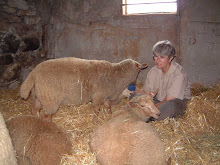Most livestock breeders have heard the term "hybrid vigour" in which the cross between two breeds grows better than either of the two purebred lines. Heterosis is the formal name for this.
In the sheep world, commercial producers take advantage of this by crossing two maternal type breeds such as a Rideau Arcott with a Dorset to create an F1 cross. The F1 cross is then mated to a terminal sire breed such as a Suffolk or Hampshire. If done well, the resulting market lamb is superior than from each of the purebred lines.
We cross our two maternal lines so our F1 cross is a North Country Cheviot/Tunis cross. This hybrid is indeed strong, vigorous and grows well. We are still working on which terminal sire breed works best with this cross and our production system. We are trying a Hampshire cross this year.
With heterosis comes a certain degree of unpredictability. However that unpredictability is reduced if the two parental purebred lines used are inbred. While you always create your cross from the best of your purebred lines, the mixing of genotypes leads to less predictability in the resulting phenotype ie how the animal will look and perform. In some extreme cases the parental genes are incompatable and the hybrid is less vigorous than the parental lines. This is where data collection is very important.
It is common practice for breeders of purebred stock to line breed, that is mate closely related relatives to enhance desirable characteristics such a growth rate or conformation type. This increases homogeniety and predictability of the offspring but also can come at a cost known as inbreeding depression. The extreme of this is the appearance of lethal recessives such as spider syndrome in Suffolk sheep.
The reality is that breeding selection is focussed on relatively few measurable characteristics and the rest of the genome comes along for the ride. In some cases the changes are positive, some negative but on the whole the inbred animal is less gentically fit than an animal that is outcrossed.
While our purebred lines (especially our Cheviots) have some very desirable measurable characteristics, in my opinion, they are too inbred and we will be searching for unrelated lines to use for an outcross.
Lately I have been reading articles on the impact of inbreeding on disease and parasite resistance in sheep and am seeing the fitness advantage of the heterozygote.
There is very little in the livestock literature on the impact of inbreeding on parasite resistance but there is information on wild populations of sheep. In these publications, inbred lines are more susceptible to internal parasites working as a natural selection against inbred lines.
Scrapie is another instance. At first blush it makes sense to include selection for resistant lines in your breeding program. However it never makes sense to breed for a single characteristic. In this case, adding resistance to your flock should be done slowly without sacrificing production characteristics. I know that in 18th century Britain scrapie was thought to be the result of inbreeding; maybe they were right. Is heterozygosity the way to go with respect to scrapie ie gaining some resistance, not sacrificing other characteristics? At this point I can honestly say I am not sure. We will continue to genotype and use quality rams with resistance genotypes. However, we will not sacrifice quality in a effort to maximize resistance.
Breeding livestock is not a set formula but rather a dance where you go back and forth but ultimately make your way across the dance floor. Your goal is to move forward but that requires knowledge, research and accurate,detailed data collection. I strongly feel that a wholistic approach needs to be used where the health, longevity, fertility and welfare of the animal has to be considered. You may not make as rapid advances in characteristics such as rate of gain but I am banking on this approach reducing your costs by producing a healthier and more "genetically fit" animal.
TTFN,
Laurie
Tuesday, April 24, 2012
Heterosis or the healthy mutt
Subscribe to:
Post Comments (Atom)


No comments:
Post a Comment